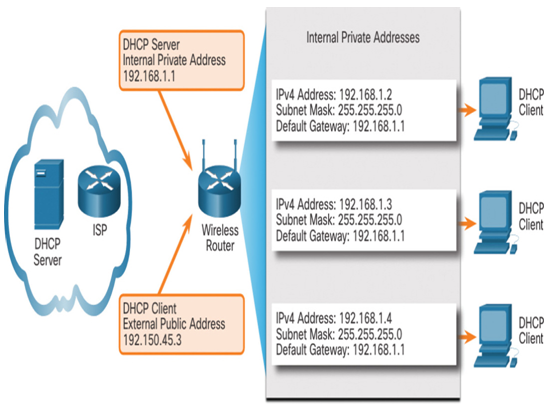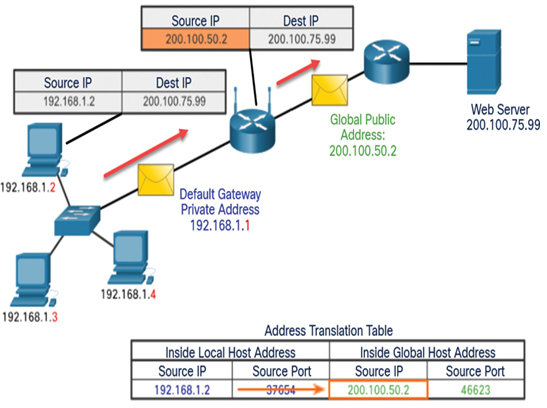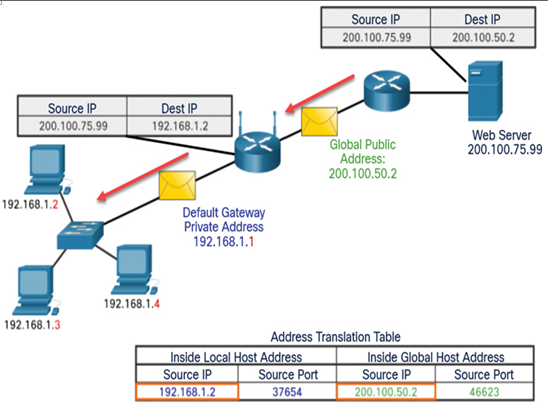The wireless router acts as a DHCP server for all local hosts attached to it, either by Ethernet cable or wirelessly. These local hosts are referred to as being located on an internal, or inside, network. Most DHCP servers are configured to assign private addresses to the hosts on the internal network, rather than internet routable public addresses. This ensures that, by default, the internal network is not directly accessible from the internet.
The default IPv4 address configured on the local wireless router interface is usually the first host address on that network. Internal hosts must be assigned addresses within the same network as the wireless router, either statically configured, or through DHCP. When configured as a DHCP server, the wireless router provides addresses in this range. It also provides the subnet mask information and its own interface IPv4 address as the default gateway, as shown in Figure 12-2.

Figure 12-2 Default Router as Both a DHCP Server and a DHCP Client
Many ISPs also use DHCP servers to provide IPv4 addresses to the internet side of the wireless router installed at their customer sites. The network assigned to the internet side of the wireless router is referred to as the external, or outside, network.
When a wireless router is connected to the ISP, it acts like a DHCP client to receive the correct external network IPv4 address for the internet interface. ISPs usually provide an internet-routable address, which enables hosts connected to the wireless router to have access to the internet.
The wireless router serves as the boundary between the local internal network and the external internet.
Check Your Understanding – Network Boundaries (12.1.4)
Refer to the online course to complete this activity.
Network Address Translation (12.2)
The number of public IPv4 addresses is severely limited, which was one of the primary reasons for RFC 1918 private IPv4 addresses. Network Address Translation (NAT) for IPv4 provides for the translation between private and public IPv4 addresses.
The wireless router receives a public address from the ISP, which allows it to send and receive packets on the internet. It, in turn, provides private addresses to local network clients. Because private addresses are not allowed on the internet, a process is needed for translating private addresses into unique public addresses to allow local clients to communicate on the internet.
The process used to convert private addresses to internet-routable addresses is called Network Address Translation (NAT). With NAT, a private (local) source IPv4 address is translated to a public (global) address. The process is reversed for incoming packets. The wireless router is able to translate many internal IPv4 addresses to the same public address, by using NAT.
Only packets destined for other networks need to be translated. These packets must pass through the gateway, where the wireless router replaces the private IPv4 address of the source host with its own public IPv4 address.
Although each host on the internal network has a unique private IPv4 address assigned to it, the hosts must share the single internet-routable address assigned to the wireless router.
In Figures 12-3 and 12-4, a home router translates packets using NAT.

Figure 12-3 Wireless Router using NAT to Translate Outbound Traffic

Figure 12-4 Wireless Router using NAT to Translate Inbound Traffic
Video – Introduction to NAT (12.2.1)
Refer to the online course to view this video.
Packet Tracer – Examine NAT on a Wireless Router (12.2.2)
In this activity, you will complete the following objectives:
• Examine NAT configuration on a wireless router.
• Set up 4 PCs to connect to a wireless router using DHCP.
• Examine traffic that crosses the network using NAT.
Refer to the online course to complete this Packet Tracer.
